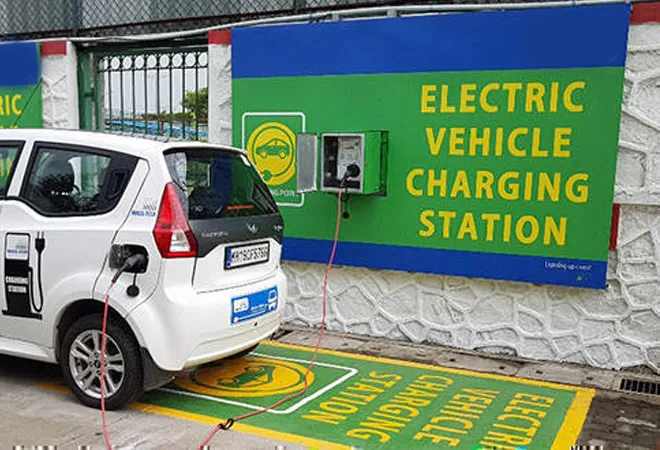
The transport sector is responsible for around 23 percent of global carbon emissions and is expected to grow faster than most other sectors. In this context, Day 10 at the COP26 summit was designated as transport day. The agenda for the day was to increase collaboration between different stakeholders to accelerate a transition to low-carbon mobility.
The most significant takeaway was the
COP26 declaration on the accelerated transition to 100 percent zero-emission cars and vans. The declaration states that all new car and van sales will be zero-emission by 2040 across the world. For leading markets, the target is set at 2035. The non-binding agreement has been signed by governments, automotive manufacturers, financial institutions, and civil society organisations. Thirty-three governments have signed the agreement. India, represented by NITI Aayog, has also joined the declaration, specifically highlighting the importance of transitioning two- and three-wheelers. Conspicuously, two of the largest transport emitters, the United States (US) and China, are absent. Although certain cities in these countries have agreed to sign. The only other notable development from transport day was related to commitments from industry and conglomerations to promote low-carbon fuels for the shipping and aviation industries.
The focus on zero-emission vehicles will allow developed countries to remain on their present pathways with the promise that newer vehicles will be cleaner.
The focus on zero-emission vehicles aims at lowering tailpipe emissions from vehicles to align with an overall net-zero goal by 2050. The focus this year was largely on electric vehicles (EVs). The key driving force behind this is the high motorisation rates in most developed countries. For example, the US and United Kingdom (UK) have a motorisation rate of 816 and 491 vehicles per 1,000 people, respectively. These countries have a very high proliferation of private vehicles, driven by higher per capita income and skewed investment towards road infrastructure and incentives for the automobile industry. The focus on zero-emission vehicles will allow developed countries to remain on their present pathways with the promise that newer vehicles will be cleaner.
In effect, the transport day at COP26 could be better titled ‘electric vehicle day.’ However, efforts at decarbonising transport need to go beyond simply improving the performance of motor vehicles. Other strategies within the ‘avoid-shift and improve’ framework need to be considered. Avoiding or reducing motorised transport demand is the most effective way of reducing emissions. This requires creating compact cities, promoting non-motorised transport and enabling transit-oriented development. Shifting demand to more energy-efficient modes such as rail and buses is also crucial. Commitments to these interventions have been largely absent in the COP26 discourse in favour of zero-emission motor vehicles. This has also led to protest from civil society organisations outside the COP26 venue, demanding a greater focus on cycling and public transport.
Indian perspective
The electric mobility transition is certainly necessary. India is the largest market for two- and three-wheelers in the world—segments ideally suited for the EV transition. Private cars and light commercial vehicle sales have also increased exponentially in the last two decades and are likely to continue to grow. EVs will be important for these segments as well.
A study by The Energy and Resources Institute (TERI) suggests that easier-to-transition segments for EVs could account for around 25 percent of the total carbon emissions. India already has a robust policy for EVs at the Central and State level. By entering into the COP26 declaration, we have further boosted our EV ambitions. India is emerging as a leader in the EV transition in developing countries.
However, the present development pathway of transport in India is quite different from developed countries and needs to be accounted for in any decarbonisation effort. The motorisation rate in India is much lower than in other countries, around 32 vehicles per 1,000 people. Indians are still heavily dependent on non-private modes of travel. Public transport plays a major role in meeting travel demand, accounting for more than
50 percent of the total modal share in some cities such as Mumbai. The average travel distance to work in India is also less than six kilometres for most cities, ideally suited for non-motorised transport. As a result, the share of walking and cycling also remains high. However, inadequate capacity investments have led to a
recent decline in the share of these modes in favour of private vehicles.
The present development pathway of transport in India is quite different from developed countries and needs to be accounted for in any decarbonisation effort.
The COP26 summit provided India with an opportunity to highlight some of the pressing needs for a just and equitable mobility transition, in addition to electric vehicles. A large part of public transport and Non-Motorised Transport (NMT) users in India are captive users, unable to afford any other mode of travel. Further, as per capita incomes rise, private vehicle usage will rise without adequate access to affordable and customer-friendly public transport. Thus, improved public transport and NMT are essential to meet the dual goals of environmental and social sustainability. In contrast, the present approach of incentivising uptake of EVs primarily benefits high-income consumers with adequate access to formal finance.
Public transport
As per a NITI Aayog
study, India has a very low per capita proliferation of buses, around 1.2 buses per 1,000 people. Much lower than other developing countries, including Thailand (8.6 per 1,000) and South Africa (6.5 per 1,000). Further, around
25 percent of on-road buses in India are overaged, leading to poor customer experience and fuel efficiency. The investment required for improving the public transport system is substantial. A 2016
study by the Investment Information and Credit Rating Agency of India Limited (ICRA) estimated that an investment of around US $15.4 billion would be required to procure 150,000 new buses. If these buses are to be electric, the required capital investment will be much higher given the cost differential between electric and diesel-based buses. A
study by the Janaagraha Centre for Citizenship and Democracy estimated that an ambitious e-bus procurement plan would cost the Karnataka State Transport Corporation four times the capital investment compared to diesel buses.
Mobilising such a high quantum of funds will be a daunting task for cash-strapped State Transport Undertaking (STUs). Presently, STUs incur a combined annual loss to the tune of
INR 14,000 crore. Additionally, the money will need to come primarily from non-fare revenues since the scope for increasing fares is limited. Innovative financial mechanisms will be required. Some of the funding can come from state and central governments. However, there is a need to create mechanisms by which international green funds can be channelled to STUs, either as low-interest debt or equity through partnerships with auto manufacturers or bus operators. There is also a need to consider other low-carbon fuels like LNG and CNG, given the higher cost of EVs. These fuels could be especially viable in states which are close to ports of entry for these natural gas alternatives, such as Kerala and Gujarat. A stronger appeal at a forum such as COP26 could have created more pressure on international funding agencies to consider buses as a primary avenue of investment.
Non-motorised transport
NMT primarily includes all zero carbon modes such as walking, cycling, and using cycle rickshaws. Low-income households depend heavily on NMT. Making cities NMT-friendly is essential to provide safe mobility to the poorest sections of society. Integrated NMT infrastructure is also essential for improving the share of public transport by providing the most affordable first and last-mile option. Despite this, these modes have been amongst the most neglected by policymakers. An
analysis of the transport budget for five cities by The Pariksar Sanrakshan Sanvardhan Sanstha found that only 2 percent of transport expenditure was on NMT. Further,
data from the Ministry of Road Transport and Highways (MoRTH) shows that around 20 percent of all road accidents in India involve NMT.
There is a need to create mechanisms by which international green funds can be channelled to STUs, either as low-interest debt or equity through partnerships with auto manufacturers or bus operators.
NMT has received a lot of attention in overarching policy documents such as the National Urban Transport Policy. However, actual on-ground implementation has been an issue due to inadequate capacity and funding. Presently, NMT planning comes under the aegis of local city authorities. These bodies lack the specific urban planning expertise required to implement NMT infrastructure. Funding is also an issue since city authorities tend to favour investments in megaprojects related to road and flyover construction. There is a need to create specific NMT cells with adequate expertise in planning and execution within planning authorities at the city level. These cells should be provided with dedicated funds for the planning and implementation of pedestrian and cycling infrastructure. These cells can also collaborate with the private sector to integrate bike-sharing and micro-mobility interventions, such as e-bikes, into the existing system. The COP26 summit provided a good opportunity for India to highlight the importance of NMT and increase its ambition towards improving NMT. This would have created the right incentives for city authorities to direct their focus to NMT.
A missed opportunity
Through its commitments to enable zero-emission vehicles, India has shown much more ambition than some other developing countries. However, we have missed an opportunity to bring forth a broader perspective on an equitable and just mobility transition accounting for the innate difference in mobility patterns between developed and developing countries.
Public transport and NMT must be the pillars of a just and equitable low-carbon mobility transition in India. The commitments at international summits such as COP26 often define the direction of national policies as well as international finance. The present focus of international green funds in transport is limited to EVs and metro rail. An example of this is the US $944-million
green growth equity fund, which only focuses on enabling charging infrastructure. There is a need to bring the broader set of mobility issues to the table to direct funds to other critical areas such as the public bus system and NMT.
The views expressed above belong to the author(s). ORF research and analyses now available on Telegram! Click here to access our curated content — blogs, longforms and interviews.



 The transport sector is responsible for around 23 percent of global carbon emissions and is expected to grow faster than most other sectors. In this context, Day 10 at the COP26 summit was designated as transport day. The agenda for the day was to increase collaboration between different stakeholders to accelerate a transition to low-carbon mobility.
The most significant takeaway was the
The transport sector is responsible for around 23 percent of global carbon emissions and is expected to grow faster than most other sectors. In this context, Day 10 at the COP26 summit was designated as transport day. The agenda for the day was to increase collaboration between different stakeholders to accelerate a transition to low-carbon mobility.
The most significant takeaway was the  PREV
PREV


